Description
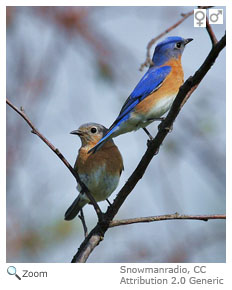 A favorite of bird watchers, the Eastern Bluebird is loved for its brilliant color and easy viewing. It is often seen sitting on telephone lines and near nest boxes. 6-8 inches in length, the Eastern Bluebird is slightly smaller than a robin. The male has a bright blue back with a red and white belly. The female is gray in color with blue areas on the wings and tail. A favorite of bird watchers, the Eastern Bluebird is loved for its brilliant color and easy viewing. It is often seen sitting on telephone lines and near nest boxes. 6-8 inches in length, the Eastern Bluebird is slightly smaller than a robin. The male has a bright blue back with a red and white belly. The female is gray in color with blue areas on the wings and tail.
Range
The Eastern Bluebird has a very large range. It is found east of the Rocky Mountains, from Southern Canada to the Gulf Coast and into Mexico. Its range extends to the East Coast.
Habitat
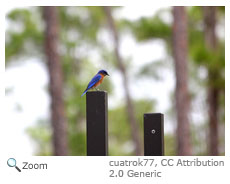 The Eastern Bluebird is found in open land with scattered trees and other high spots for perching, nesting and hunting. It is often found in parks, gardens, fields and other open areas. The Eastern Bluebird is found in open land with scattered trees and other high spots for perching, nesting and hunting. It is often found in parks, gardens, fields and other open areas. |
|
Diet
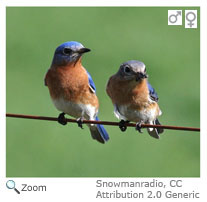 The Eastern Bluebird eats insects such as caterpillars, beetles, crickets, grasshoppers and spiders. The bluebird swoops down from its perch to catch insects on the ground. In the fall and winter, it eats fruit from sumac, blueberry, black cherry, tupelo, wild holly and others fruiting plants. The Eastern Bluebird seems to prefer running water rather to standing water. The Eastern Bluebird eats insects such as caterpillars, beetles, crickets, grasshoppers and spiders. The bluebird swoops down from its perch to catch insects on the ground. In the fall and winter, it eats fruit from sumac, blueberry, black cherry, tupelo, wild holly and others fruiting plants. The Eastern Bluebird seems to prefer running water rather to standing water.
Life Cycle
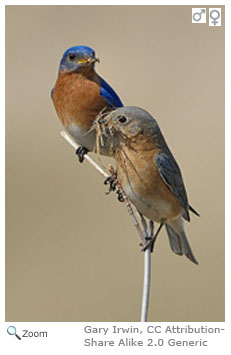 Breeding occurs in the spring and summer. The Eastern Bluebird builds its nest in a tree cavity or a man-made nest box. The female builds the nest by weaving together grasses and pine needles and lines the nest with fine grasses and soft, downy material. She may use this nest several times. The female lays 3-7 light blue eggs, which she incubates for 13-17 days. Young chicks leave the nest 15-20 days after hatching. Both the male and female feed the young insects. The Eastern Bluebird can live for 6-10 years. Breeding occurs in the spring and summer. The Eastern Bluebird builds its nest in a tree cavity or a man-made nest box. The female builds the nest by weaving together grasses and pine needles and lines the nest with fine grasses and soft, downy material. She may use this nest several times. The female lays 3-7 light blue eggs, which she incubates for 13-17 days. Young chicks leave the nest 15-20 days after hatching. Both the male and female feed the young insects. The Eastern Bluebird can live for 6-10 years.
Behavior
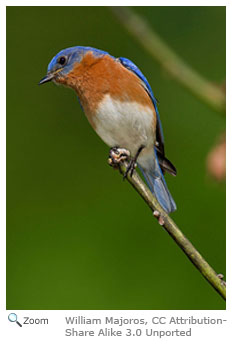 The Eastern Bluebird has been recorded flying at speeds of 17 miles per hour! The Eastern Bluebird has been recorded flying at speeds of 17 miles per hour!
The habitat of the Eastern Bluebird has been threatened by land development, which has reduced the amount of available habitat. Additionally, bird species of the same size, such as the house sparrow, compete with the Eastern Bluebird for nesting sites. Nesting boxes have been built and installed to stabilize their population. |





